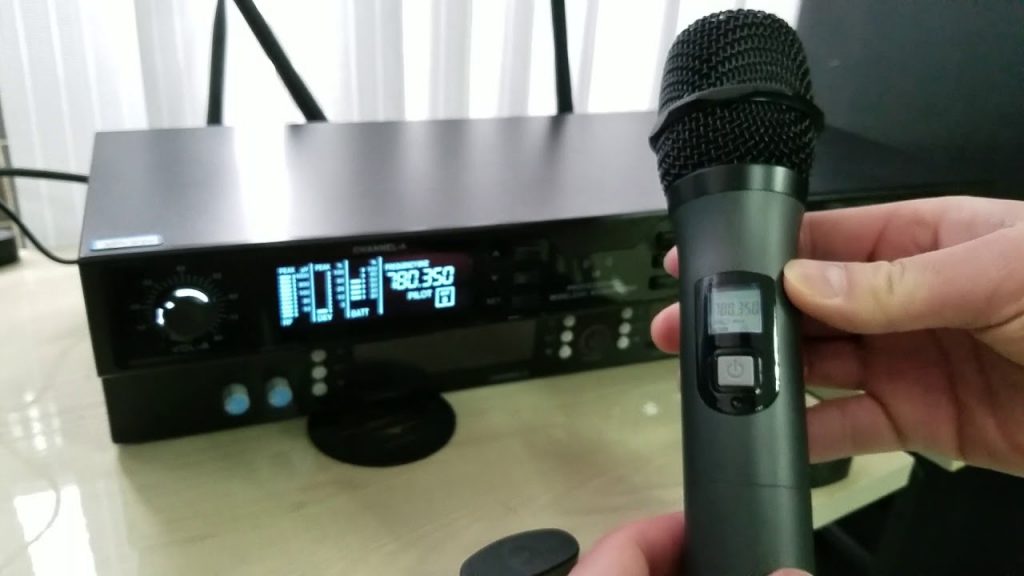How many wireless microphones can you use at once? It’s a question that plagues those who need to use them for churches, other places of worship, events, whether it’s a wedding, musical performance, or any other type of event.
The answer, unfortunately, is not as straightforward as you would hope. It depends on a number of factors, including the make and model of the receiver, the frequency they operate on, and local interference.
But how many wireless microphones can you use at once without causing interference? Let’s take a look.
Factors Affecting the Number of Wireless Microphones You Can Use

There are a few factors that can affect the number of wireless microphones you can use at one time.
The Make and Model of the Receivers
You’ll need to take into account the number of channels available on your receiver. Most receivers have between two and eight channels. The more channels a receiver has, the more microphones can be used at once.
You’ll also need to consider the number of frequencies available on your receiver. If you’re using a single-frequency receiver, then you’ll only be able to use one microphone at a time. However, if you’re using a multiple-frequency receiver, then you’ll be able to use multiple microphones at once. Multiple-frequency receivers are typically more expensive than single-frequency receivers, but they offer a lot more flexibility when it comes to using multiple microphones.
Another thing that determines how many wireless microphones can be used at once is the antenna system on the receiver. If the receiver has a built-in antenna, then it will be limited to two or three channels. However, if the receiver has an external antenna, then it will be able to support more channels. This is because external antennas are able to pick up signals from further away than built-in antennas.
The Frequency the Wireless Microphone Operates On
Another factor that determines how many wireless microphones can be used at once is the frequency that they operate on. There are two main frequency ranges for wireless microphones: UHF (ultra-high frequency) and VHF (very high frequency).
UHF wireless microphones are less prone to interference than VHF because they operate on a different wavelength. However, they are also more expensive than VHF models. If you need to use more than three wireless microphones, you will need to purchase UHF models.
Local Interference
Another factor that determines how many wireless microphones can be used at once is local interference. Interference can come from a number of sources, including baby monitors, cordless phones, microwaves, and WiFi routers.
If you live in an area with a lot of interference, you may need to purchase additional wireless microphone receivers so that each microphone has its own dedicated receiver. This will ensure that the signal from each microphone is not interfered with by other devices in the area.
How Many Wireless Microphones Can I Use at Once?

Wireless microphones use radio frequencies (RF) to transmit audio signals from the microphone to the receiver. The receiver then sends the signal to the sound system so that it can be amplified and heard by everyone in the room.
The number of wireless microphones that can be used at one time is determined by the amount of RF spectrum that is available in your area. In general, you can use up to 4-6 wireless microphones at one time without causing interference. However, this number can vary depending on the number of other RF devices that are in use near you, such as cordless phones, baby monitors, etc.
If you’re not sure how many wireless microphones you can use in your area, your best bet is to contact your local radiofrequency coordinator. They will be able to give you a more accurate estimate based on your specific location and situation.
How Far Apart Should Wireless Mic Frequencies Be?
Blog Introduction: If you’re using a wireless mic system, it’s important to make sure that the frequencies of your microphones are far enough apart so as to avoid interference. At 600 MHz, the minimum distance between frequencies should be 5 inches.
What Is Interference?
Interference is any signal that disrupts the normal operation of another signal. In the case of wireless microphones, interference can come from other wireless devices, such as Bluetooth speakers or baby monitors. Interference can also come from objects in the environment, like metal filing cabinets or concrete walls.
Why Does Distance Matter?
The further apart your wireless mic frequencies are, the less likely they are to experience interference. Interference can result in signal dropouts and other audio problems. It can also make it difficult for the receiver to pick up the signal from the transmitter. In extreme cases, interference can even cause the transmitter and receiver to lose sync with each other. So it’s important to avoid it if at all possible.
When placing your wireless microphones, make sure to take into account the minimum distance required between frequencies. This will help ensure that you get the best possible sound quality from your system.
How to Set Wireless Microphone Frequencies

If you’ve ever been to a live event, you know that there’s nothing worse than hearing feedback from a microphone. To avoid this, sound engineers have to be very careful when setting the frequencies for wireless microphones. We’ll show you how to set the frequency of a wireless microphone so that you can avoid that Feedback Loop of Doom(TM).
- The first step is to find the right frequency for your microphones. The best way to do this is to use a frequency chart. You can find these online or in magazines such as Radio World.
- Once you’ve found the right frequency, it’s time to set your transmitter. To do this, you’ll need to access the menu on your wireless microphone system.
- Once you’re in the menu, look for the “Frequency” or “Channel” option. Select it and then enter in the frequency that you want your microphones to operate on.
- Once you’ve entered in the correct frequency, hit the “Save” or “Store” button so that your changes will be saved.
And that’s all there is to it! By following these simple steps, you can make sure that your wireless microphones are operating on the correct frequency and avoid those embarrassing feedback moments.
Read More: How Do Wireless Microphones Work?
Conclusion
Using a wireless microphone system is a great way to improve audio quality while giving yourself or others the freedom to move around without being tethered to a cable. But how many wireless microphones can you use at once?
In general, you can use up to 4-6 wireless microphones without causing interference, but this number may vary depending on your specific situation. If you’re not sure, your best bet is to contact your local radiofrequency coordinator for more information.




